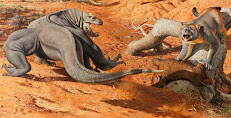The Giants of Madagascar: Lost to Climate Change and Human Impact
Madagascar is an island with a rich and unique biosphere, home to numerous endemic species found nowhere else on the planet.
Unfortunately, many of these species, including giant lemurs, elephants and birds, have disappeared over the past millennia.
Scientists believe that this extinction is largely due to climate change and human activities.
Climate change:
Madagascar's climate has changed significantly over millions of years. These changes included periods of drought, floods and changes in temperature.
Such changes could negatively affect the population of giant animals, which could not adapt to new conditions.
Human influence:
Humans arrived in Madagascar about 2,000 years ago.
Since then, human activities such as deforestation, hunting and agriculture have had a significant impact on the island's environment.
Extinction:
Scientists believe that a combination of climate change and human influence has led to the extinction of many of Madagascar's giant animals.
For example, the giant lemur Megaladapis edwardsi, which weighed up to 250 kg, disappeared about 1,000 years ago.
The giant elephant Elephas maximus madagascariensis and the bird Aepyornis maximus, which was the largest bird in the world, also disappeared.
Consequences:
The extinction of these giant animals had a significant impact on Madagascar's ecosystem.
For example, the disappearance of lemurs led to the spread of seeds of some plants, which, in turn, threaten Madagascar.
Madagascar's story is a warning about how climate change and human activity can lead to species extinction.
It is important to take action to protect the planet's biodiversity to prevent future losses.




Comments
Post a Comment